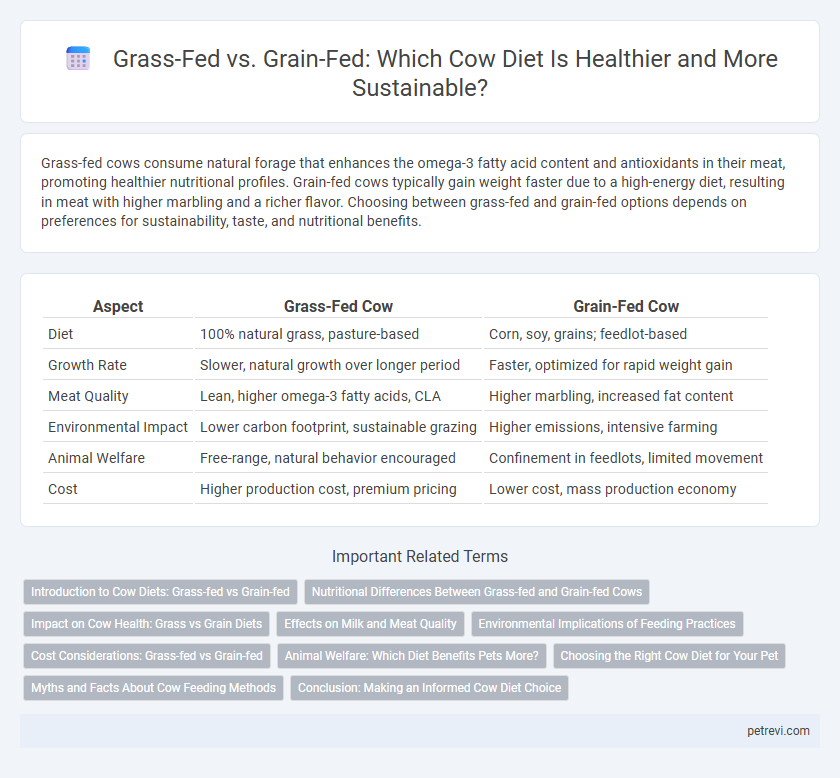Grass-fed cows consume natural forage that enhances the omega-3 fatty acid content and antioxidants in their meat, promoting healthier nutritional profiles. Grain-fed cows typically gain weight faster due to a high-energy diet, resulting in meat with higher marbling and a richer flavor. Choosing between grass-fed and grain-fed options depends on preferences for sustainability, taste, and nutritional benefits.
Table of Comparison
| Aspect | Grass-Fed Cow | Grain-Fed Cow |
|---|---|---|
| Diet | 100% natural grass, pasture-based | Corn, soy, grains; feedlot-based |
| Growth Rate | Slower, natural growth over longer period | Faster, optimized for rapid weight gain |
| Meat Quality | Lean, higher omega-3 fatty acids, CLA | Higher marbling, increased fat content |
| Environmental Impact | Lower carbon footprint, sustainable grazing | Higher emissions, intensive farming |
| Animal Welfare | Free-range, natural behavior encouraged | Confinement in feedlots, limited movement |
| Cost | Higher production cost, premium pricing | Lower cost, mass production economy |
Introduction to Cow Diets: Grass-fed vs Grain-fed
Grass-fed cows primarily consume natural pasture, which enhances their omega-3 fatty acids and antioxidant content, resulting in leaner meat and richer flavor profiles. Grain-fed cows receive a diet supplemented with corn or soy, promoting faster growth and increased marbling, often preferred for tenderness and juiciness. Understanding these feeding regimens is essential for assessing nutritional benefits, environmental impact, and meat quality in beef production.
Nutritional Differences Between Grass-fed and Grain-fed Cows
Grass-fed cows typically produce beef with higher levels of omega-3 fatty acids, conjugated linoleic acid (CLA), and antioxidants such as vitamin E and beta-carotene compared to grain-fed cows. Grain-fed cows tend to have increased intramuscular fat, resulting in a higher concentration of omega-6 fatty acids and overall marbling in the meat. These nutritional differences impact the fatty acid profile and antioxidant content, influencing both the health benefits and flavor profile of the beef.
Impact on Cow Health: Grass vs Grain Diets
Grass-fed cows benefit from higher levels of omega-3 fatty acids and antioxidants, which support better immune function and reduced inflammation. Grain-fed diets, typically richer in energy and starch, can lead to faster weight gain but increase the risk of digestive disorders and metabolic diseases like acidosis. Research shows that grass-fed cows generally exhibit improved rumen health and lower incidence of lameness compared to grain-fed counterparts.
Effects on Milk and Meat Quality
Grass-fed cows produce milk and meat with higher levels of omega-3 fatty acids, conjugated linoleic acid (CLA), and antioxidants, enhancing nutritional value and flavor. Grain-fed diets tend to increase milk yield and marbling in beef, contributing to tenderness and a sweeter taste but may result in higher saturated fats. Consumers seeking health benefits often prefer grass-fed products, while grain-fed options are favored for consistent production and specific culinary qualities.
Environmental Implications of Feeding Practices
Grass-fed cows typically contribute to lower greenhouse gas emissions due to their natural grazing patterns, which enhance soil carbon sequestration and reduce reliance on synthetic feed inputs. In contrast, grain-fed cattle often require intensive crop production that increases fertilizer use, water consumption, and deforestation risks, thereby amplifying environmental degradation. Sustainable grazing management in grass-fed systems supports biodiversity and improves ecosystem resilience while limiting the carbon footprint associated with beef production.
Cost Considerations: Grass-fed vs Grain-fed
Grass-fed cows typically incur higher costs due to extensive land use, longer growth periods, and seasonal variability in forage supply, increasing overall production expenses. Grain-fed cows often experience faster weight gain and lower feed costs, benefiting from concentrated, nutrient-dense feed formulated for maximum efficiency. Producers weigh these cost differences against market demand for grass-fed beef, which often commands premium pricing despite higher production costs.
Animal Welfare: Which Diet Benefits Pets More?
Grass-fed cows generally experience better animal welfare due to access to natural forage and open pastures, promoting healthier behavior and reduced stress levels. Grain-fed diets often involve confined feeding operations, which can limit movement and expose cows to more health issues such as digestive problems. Pets benefit more from grass-fed beef as it tends to be higher in omega-3 fatty acids and antioxidants, which support overall health and vitality.
Choosing the Right Cow Diet for Your Pet
Choosing the right cow diet depends on your pet's health needs and lifestyle. Grass-fed cows tend to have higher levels of omega-3 fatty acids and antioxidants, promoting better heart health and digestion. Grain-fed diets provide faster weight gain but may increase risks of digestive issues and fatty liver disease in cows.
Myths and Facts About Cow Feeding Methods
Grass-fed cows primarily consume natural forage, which promotes higher levels of omega-3 fatty acids and antioxidants in their meat, contrary to the myth that grain-fed beef is always more nutritious. Grain-fed cattle are often unfairly blamed for poor animal welfare, yet proper grain-based diets can support faster growth and consistent meat quality without compromising cow health. Scientific studies confirm that the choice between grass-fed and grain-fed diets impacts flavor, fat composition, and environmental sustainability, dispelling oversimplified claims about either method.
Conclusion: Making an Informed Cow Diet Choice
Choosing between grass-fed and grain-fed diets for cows impacts meat quality, animal health, and environmental sustainability. Grass-fed cows typically produce leaner meat with higher omega-3 fatty acids and antioxidants, while grain-fed cattle often gain weight faster with higher marbling. Understanding these differences helps farmers and consumers make informed decisions that balance nutritional benefits, growth efficiency, and ecological impact.
Grass-fed vs Grain-fed for Cow Diet Infographic

 petrevi.com
petrevi.com